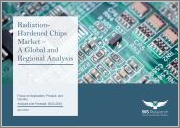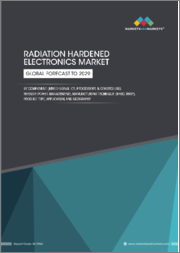
|
시장보고서
상품코드
1308716
컴퓨터 마이크로칩 시장 예측(-2030년) : 유형별, 용도별, 지역별 세계 분석Computer Microchips Market Forecasts to 2030 - Global Analysis By Type (Memory Chips, Logic Chips and Other Types), Application and By Geography |
||||||
Stratistics MRC에 따르면 세계의 컴퓨터 마이크로칩 시장은 2023년에 268억 달러를 차지하고, 2030년에는 CAGR 12.6%로 성장하며 616억 달러에 달할 것으로 예측되고 있습니다.
컴퓨터 칩은 집적 회로, 칩, 반도체 재료의 초소형 웨이퍼라고도 합니다. 최신 디지털 컴퓨터의 프로세서와 메모리 컴포넌트는 칩입니다. 기술이 발전함에 따라 트랜지스터는 나노 기술을 통해 더욱 작아지고 회로도 비례하여 더욱 강력해질 것으로 예상됩니다. 컴퓨터 마이크로칩의 수백만 개의 트랜지스터는 온·오프 스위치로 작동하고, 저항은 트랜지스터 사이를 오가는 전류를 조절하고, 커패시터는 전기를 저장하거나 방출하고, 다이오드는 에너지 흐름을 멈춥니다. 마이크로칩은 부품의 분리를 없애고 컴퓨터의 크기를 줄일 수 있습니다. 집적 회로는 저렴한 가격으로 더 많은 부품을 탑재 할 수 있습니다.
시장 역학 :
촉진요인 :
소형 경량 가젯 수요 증가
이 업계에서 가장 성장 가능성이 높은 분야 중 하나는 기술 혁신입니다. 휴대폰 제조업체들은 자사 제품에 이러한 반도체 칩을 많이 사용하고 있으며, 판매 호조로 인해 이들 제조업체는 칩 제조업체에 고품질 부품을 공급하도록 적극적인 압력을 가하고 있습니다. 이에 따라 각 업체들은 이러한 첨단 기술 대기업과공급 계약을 따내기 위해 혁신적인 제품을 개발하게 됩니다. 산업 확장에 박차를 가할 수 있는 또 다른 요소는 소형화, 경량화에 대한 수요 증가로 인한 전자 부품의 소형화 추세입니다.
억제요인
컴퓨터 수요 감소
PC 수요 감소는 컴퓨터 마이크로칩 세계 시장 성장을 가로막는 주요 장애물 중 하나입니다. 스마트폰과 태블릿PC의 휴대성과 사용 편의성이 높아지면서 PC 시장이 축소되고 있습니다. 이에 따라 컴퓨터용 마이크로칩 수요는 감소하고 있습니다. 그러나 시장 성장을 저해할 수 있는 도전과제를 극복해야할 것으로 예상됩니다.
기회
컴퓨팅 파워에 대한 수요 증가
컴퓨터 마이크로칩에 대한 수요는 세계에서 빠르게 증가하고 있습니다. 그 배경에는 처리 능력에 대한 수요 증가, 마이크로칩 가격 하락, 마이크로칩의 응용 범위 확대 등 여러 가지 요인이 있습니다. 사물인터넷(IoT), 인공지능(AI), 빅데이터 등으로 인해 처리 능력에 대한 수요가 증가하고 있습니다. 마이크로칩은 이러한 기술을 실행하는 데 필요한 점점 더 강력해지는 컴퓨터의 핵심 컴포넌트입니다.
위협
대체기술로 인한 경쟁자 증가
컴퓨터용 마이크로칩 세계 시장 발전를 가로막는 것은 대체 기술과의 경쟁 심화다. 마이크로칩을 대체할 수 있는 다양한 대체 기술이 시장에 제공되고 있습니다. 마이크로칩은 효과와 효율성에서 이러한 최신 기술을 따라잡을 수 없습니다. 그 결과 마이크로칩을 구입하는 사람이 줄어들고 시장 성장이 둔화될 것으로 예상됩니다.
COVID-19의 영향 :
COVID-19 팬데믹은 컴퓨터 마이크로칩 시장에 큰 부정적인 영향을 미치고 있으며, OEM, 공급업체, 통합업체, 최종사용자, 유통업체 등 밸류체인의 다양한 부문에 종사하는 수많은 업계 전문가들의 의견과 컴퓨터 마이크로칩 생태계내 다양한 기업의 재무 정보 공개를 바탕으로 시장이 축소된 것으로 판단됩니다. 세계 공급망도 전염병 발생으로 인해 중단되어 시스템에 큰 공백이 생겼습니다. 전염병으로 인한 파괴적인 경제 효과가 나타나고 있습니다.
예측 기간 중 메모리 칩 부문이 가장 큰 비중을 차지할 것으로 예상 :
메모리 칩 부문은 건강 모니터링으로 인해 유리한 성장세를 보일 것으로 추정됩니다. 그 장점은 도난과 사기에 대응할 수 있는 능력과 마이크로칩 용도의 새로운 물결로 요약할 수 있습니다. 마이크로칩으로 알려진 컴퓨터 칩은 현대 컴퓨팅의 핵심입니다. 수백만 개의 트랜지스터가 작은 실리콘 웨이퍼에 탑재되어 데이터를 처리하고 저장할 수 있습니다. 마이크로칩의 크기, 복잡성, 성능은 다양하지만, 모두 사람이 하는 것보다 더 빠르고, 정확하고, 효율적으로 작업을 수행할 수 있는 기술을 구현하는 데 사용됩니다.
예측기간 중 가장 높은 CAGR을 기록할 것으로 예상되는 분야는 자동차 분야
예측 기간 중 CAGR이 가장 빠르게 성장할 것으로 예상되는 분야는 자동차 분야입니다. 이 시장은 자동차, 트럭, 버스로 구성되어 있습니다. 반도체는 전자의 흐름을 제어하는 일종의 전기 회로 역할을 하며 현대 전자제품의 두뇌 역할을 합니다. 이 시장을 위해 반도체 산업은 센서, 마이크로컨트롤러, 전력 관리용 집적회로 등 다양한 제품을 제공합니다.
가장 큰 점유율을 차지하는 지역 :
아시아태평양은 신흥 국가의 PC, 스마트폰, 태블릿 등 전자제품 수요 증가로 인해 예측 기간 중 가장 큰 시장 점유율을 차지할 것으로 예상됩니다. 마이크로칩은 저렴한 원자재와 방대한 생산 능력을 갖춘 중국에 큰 기회가 있습니다. 중국의 기술 발전이 빠르고 설비 투자 비용이 높기 때문에 시장이 크게 성장할 것으로 예상됩니다.
CAGR이 가장 높은 지역 :
유럽은 소형 스마트 기기의 채택이 증가함에 따라 예측 기간 중 가장 높은 CAGR을 기록할 것으로 예상됩니다. 소비자 전자기기의 소비 증가는 핸드헬드 마이크로컴퓨터 프로세서에 대한 수요 증가와 함께 산업의 급속한 성장을 주도하고 있습니다. 또한 사물인터넷과 자동화 프로세스의 발전으로 인해 고성능 및 소형 마이크로칩의 필요성이 증가하면서 시장 수요를 촉진할 것으로 예상됩니다.
주요 발전 :
지난 3월, 브로드컴의 CEO Hock Tan은 회사의 1분기 매출이 사상 최고치인 77억 달러에 달했다고 발표했지만, 곧이어 칩 수주 잔고가 전분기 대비 두 자릿수 증가했다고 비난했습니다.
삼성전자와 IBM은 지난 12월, 새로운 수직형 트랜지스터 아키텍처를 활용한 반도체 설계 혁신을 발표하며 나노시트를 넘어서는 스케일링의 길을 제시했습니다.
보고서 내용
- 지역 및 국가별 시장 점유율 평가
- 신규 진입기업에 대한 전략적 제안
- 2021년, 2022년, 2023년, 2026년, 2030년 시장 데이터를 다룹니다.
- 시장 동향(시장 성장 촉진요인, 저해요인, 기회, 위협, 과제, 투자 기회 및 권장 사항)
- 시장 추정에 기반한 주요 사업 부문에 대한 전략적 제안
- 주요 공통 트렌드를 매핑한 경쟁 구도
- 상세한 전략, 재무 및 최근 동향을 포함한 기업 개요
- 최신 기술 발전을 매핑하는 공급망 동향
무료 커스터마이제이션 서비스 :
이 보고서를 구독하는 고객에게는 다음 중 하나의 무료 커스터마이제이션 옵션을 제공합니다.
- 기업 개요
- 추가 시장 기업의 종합적 프로파일링(3사까지)
- 주요 기업의 SWOT 분석(3사까지)
- 지역 세분화
- 고객의 관심에 따른 주요 국가별 시장 추정 및 예측, CAGR(주 : 실현 가능성 체크에 따름)
- 경쟁 벤치마킹
- 제품 포트폴리오, 지역적 입지, 전략적 제휴에 기반한 주요 기업의 벤치마킹
목차
제1장 주요 요약
제2장 서문
- 개요
- 이해관계자
- 조사 범위
- 조사 방법
- 데이터 마이닝
- 데이터 분석
- 데이터 검증
- 조사 어프로치
- 조사 소스
제3장 시장 동향 분석
- 촉진요인
- 억제요인
- 기회
- 위협
- 애플리케이션 분석
- 신흥 시장
- 신종 코로나바이러스 감염증(COVID-19)의 영향
제4장 Porters Five Force 분석
- 공급 기업의 교섭력
- 구매자의 교섭력
- 대체품의 위협
- 신규 진출업체의 위협
- 경쟁 기업간 경쟁 관계
제5장 세계의 컴퓨터 마이크로칩 시장 : 유형별
- 메모리 칩
- 로직 칩
- 기타 유형
제6장 세계의 컴퓨터 마이크로칩 시장 : 용도별
- 자동차
- 항공우주와 방위
- 가전
- 헬스케어
- 기타 용도
제7장 세계의 컴퓨터 마이크로칩 시장 : 지역별
- 북미
- 미국
- 캐나다
- 멕시코
- 유럽
- 독일
- 영국
- 이탈리아
- 프랑스
- 스페인
- 기타 유럽
- 아시아태평양
- 일본
- 중국
- 인도
- 호주
- 뉴질랜드
- 한국
- 기타 아시아태평양
- 남미
- 아르헨티나
- 브라질
- 칠레
- 기타 남미
- 중동 및 아프리카
- 사우디아라비아
- 아랍에미리트
- 카타르
- 남아프리카공화국
- 기타 중동 및 아프리카
제8장 주요 발전
- 계약, 파트너십, 협업, 합병사업
- 인수합병
- 신제품 발매
- 사업 확대
- 기타 주요 전략
제9장 회사 개요
- Samsung
- TSMC
- Broadcom Inc
- Intel Corporation
- Micron Technology Inc
- NUVIA Corporation
- AMD
- Qualcomm Inc
- NXP Semiconductors NV
- Infineon
- Texas Instruments Inc
- Advanced Micro Devices INC
- Taiwan Semiconductor Manufacturing Co. Ltd
- ST Microelectronics NV
- Celera
- GCT Semiconductor
According to Stratistics MRC, the Global Computer Microchips Market is accounted for $26.8 billion in 2023 and is expected to reach $61.6 billion by 2030 growing at a CAGR of 12.6% during the forecast period. A computer chip may also be referred to as an integrated circuit, a chip, or a tiny wafer of semiconductor material. The processor and memory components of a modern digital computer are chips. As technology develops, transistors are anticipated to become even tiny thanks to nanotechnology, and circuits to become proportionally more powerful. Millions of transistors on a computer microchip operate as on-and-off switches, while resistors regulate the electricity currents that travel back and forth between the transistors, capacitors store and release electricity, and diodes halt the flow of energy. Microchips make it unnecessary to segregate a component, which reduces the size of computers. An integrated circuit can accommodate more components for a lower price.
Market Dynamics:
Driver:
Growth in demand for small, light gadgets
One of the industries' most promising areas for growth is innovation. Mobile phone manufacturers use a lot of these semiconductor chips in their products, and because of their strong sales, these companies continue to put active pressure on chip manufacturers to supply them with high-quality components. This encourages various manufacturers to come up with innovative products in an effort to land supply deals with such tech giants. Another element that may spur industry expansion is the ongoing reduction in the size of electronic components due to the rise in demand for small and light gadgets.
Restraint:
Declining personal computer demand
The decline in demand for personal computers is one of the main obstacles preventing the global market for computer microchips from growing. Since smartphones and tablets are more portable and user-friendly, there has been a decline in the market for personal computers. As a result, there is less of a demand for personal computer microchips. But it's anticipated that there will be some challenges the market must overcome that could prevent it from growing.
Opportunity:
Rising demand for computing power
The need for computer microchips is rising quickly on a global scale. This is caused by a variety of elements, such as the growing need for computing power, the falling price of microchips, and the expanding range of microchip applications. The demand for processing power is rising as a result of the Internet of Things (IoT), AI, and big data. Microchips are a crucial component of the increasingly powerful computers that are needed to run these technologies.
Threat:
Increasing rivalry from substitute technologies
The obstacle to the evolution of the worldwide market for computer microchips is the escalating competition from alternative technologies. Many different replacement technologies are offered on the market to replace microchips. Microchips cannot compete with these modern technologies for effectiveness and efficiency. As a result, the market is expected to grow more slowly as less people are expected to buy microchips.
COVID-19 Impact:
The COVID-19 pandemic epidemic has had a significant negative influence on the market for computer microchips. It is determined that the market has declined based on input from numerous industry experts from different segments of the value chain, including OEMs, suppliers, integrators, end users, and distributors, as well as the financial disclosure of different businesses in the computer microchip ecosystem. The worldwide supply chain has also been interrupted by the pandemic outbreak, leaving a huge vacuum in the system. The pandemic's disruptive economic effects have been felt.
The memory chips segment is expected to be the largest during the forecast period:
The memory chips segment is estimated to have a lucrative growth, due to the monitoring of health. The benefits can be summed up as the ability to combat theft and fraud as well as the new wave of microchip applications. Computer chips known as microchips are the cornerstone of contemporary computing. Millions of transistors are housed on these small silicon wafers, which can process and store data. The size, complexity, and power of microchips vary, but they are all used to make technology capable of carrying out tasks more quickly, correctly, and efficiently than a human could.
The automotive segment is expected to have the highest CAGR during the forecast period:
The automotive segment is anticipated to witness the fastest CAGR growth during the forecast period. This market consists of automobiles, trucks, and buses. They function as a sort of electrical circuit to control the flow of electrons, acting as the brain of contemporary electronics. For this market, the semiconductor industry provides a wide range of goods, including as sensors, microcontrollers, and integrated circuits for power management.
Region with Largest share:
Asia Pacific is projected to hold the largest market share during the forecast period owing to increasing demand for electronic products such as PCs, smartphones, and tablets in emerging countries. Microchips have a huge window of opportunity to China's inexpensive cost of raw materials and vast production capacity. It is anticipated to have a significant market growth due to its early technology advancement and expensive capital investment.
Region with highest CAGR:
Europe is projected to have the highest CAGR over the forecast period, owing to increasing adoption of compact and smart devices. Consumer electronics device consumption growth is responsible for the industry's quick expansion as well as the rise in demand for hand-held and microcomputer processors. Furthermore, the development of the Internet of Things and automation processes necessitates high-performance and compact microchips, which is predicted to fuel market demand.
Key players in the market
Some of the key players profiled in the Computer Microchips Market include Samsung, TSMC, Broadcom Inc, Intel Corporation, Micron Technology Inc, NUVIA Corporation, AMD, Qualcomm Inc, NXP Semiconductors NV, Infineon, Texas Instruments Inc, Advanced Micro Devices INC, Taiwan Semiconductor Manufacturing Co. Ltd, ST Microelectronics NV, Celera and GCT Semiconductor.
Key Developments:
In March 2022, Broadcom CEO Hock Tan announced record revenues for the company's first fiscal quarter of $7.7 billion but quickly decried a chip backlog that grew by double digits over the prior quarter.
In December 2021, Samsung and IBM jointly announced a breakthrough in semiconductor design utilizing a new vertical transistor architecture that demonstrates a path to scaling beyond nanosheet, and has the potential to reduce energy usage by 85 percent compared to a scaled fin field-effect transistor.
Types Covered:
- Memory Chips
- Logic Chips
- Other Types
Applications Covered:
- Automotive
- Aerospace and Defense
- Consumer Electronics
- Healthcare
- Other Applications
Regions Covered:
- North America
- US
- Canada
- Mexico
- Europe
- Germany
- UK
- Italy
- France
- Spain
- Rest of Europe
- Asia Pacific
- Japan
- China
- India
- Australia
- New Zealand
- South Korea
- Rest of Asia Pacific
- South America
- Argentina
- Brazil
- Chile
- Rest of South America
- Middle East & Africa
- Saudi Arabia
- UAE
- Qatar
- South Africa
- Rest of Middle East & Africa
What our report offers:
- Market share assessments for the regional and country-level segments
- Strategic recommendations for the new entrants
- Covers Market data for the years 2021, 2022, 2023, 2026, and 2030
- Market Trends (Drivers, Constraints, Opportunities, Threats, Challenges, Investment Opportunities, and recommendations)
- Strategic recommendations in key business segments based on the market estimations
- Competitive landscaping mapping the key common trends
- Company profiling with detailed strategies, financials, and recent developments
- Supply chain trends mapping the latest technological advancements
Free Customization Offerings:
All the customers of this report will be entitled to receive one of the following free customization options:
- Company Profiling
- Comprehensive profiling of additional market players (up to 3)
- SWOT Analysis of key players (up to 3)
- Regional Segmentation
- Market estimations, Forecasts and CAGR of any prominent country as per the client's interest (Note: Depends on feasibility check)
- Competitive Benchmarking
- Benchmarking of key players based on product portfolio, geographical presence, and strategic alliances
Table of Contents
1 Executive Summary
2 Preface
- 2.1 Abstract
- 2.2 Stake Holders
- 2.3 Research Scope
- 2.4 Research Methodology
- 2.4.1 Data Mining
- 2.4.2 Data Analysis
- 2.4.3 Data Validation
- 2.4.4 Research Approach
- 2.5 Research Sources
- 2.5.1 Primary Research Sources
- 2.5.2 Secondary Research Sources
- 2.5.3 Assumptions
3 Market Trend Analysis
- 3.1 Introduction
- 3.2 Drivers
- 3.3 Restraints
- 3.4 Opportunities
- 3.5 Threats
- 3.6 Application Analysis
- 3.7 Emerging Markets
- 3.8 Impact of Covid-19
4 Porters Five Force Analysis
- 4.1 Bargaining power of suppliers
- 4.2 Bargaining power of buyers
- 4.3 Threat of substitutes
- 4.4 Threat of new entrants
- 4.5 Competitive rivalry
5 Global Computer Microchips Market, By Type
- 5.1 Introduction
- 5.2 Memory Chips
- 5.3 Logic Chips
- 5.4 Other Types
6 Global Computer Microchips Market, By Application
- 6.1 Introduction
- 6.2 Automotive
- 6.3 Aerospace and Defense
- 6.4 Consumer Electronics
- 6.5 Healthcare
- 6.6 Other Applications
7 Global Computer Microchips Market, By Geography
- 7.1 Introduction
- 7.2 North America
- 7.2.1 US
- 7.2.2 Canada
- 7.2.3 Mexico
- 7.3 Europe
- 7.3.1 Germany
- 7.3.2 UK
- 7.3.3 Italy
- 7.3.4 France
- 7.3.5 Spain
- 7.3.6 Rest of Europe
- 7.4 Asia Pacific
- 7.4.1 Japan
- 7.4.2 China
- 7.4.3 India
- 7.4.4 Australia
- 7.4.5 New Zealand
- 7.4.6 South Korea
- 7.4.7 Rest of Asia Pacific
- 7.5 South America
- 7.5.1 Argentina
- 7.5.2 Brazil
- 7.5.3 Chile
- 7.5.4 Rest of South America
- 7.6 Middle East & Africa
- 7.6.1 Saudi Arabia
- 7.6.2 UAE
- 7.6.3 Qatar
- 7.6.4 South Africa
- 7.6.5 Rest of Middle East & Africa
8 Key Developments
- 8.1 Agreements, Partnerships, Collaborations and Joint Ventures
- 8.2 Acquisitions & Mergers
- 8.3 New Product Launch
- 8.4 Expansions
- 8.5 Other Key Strategies
9 Company Profiling
- 9.1 Samsung
- 9.2 TSMC
- 9.3 Broadcom Inc
- 9.4 Intel Corporation
- 9.5 Micron Technology Inc
- 9.6 NUVIA Corporation
- 9.7 AMD
- 9.8 Qualcomm Inc
- 9.9 NXP Semiconductors NV
- 9.10 Infineon
- 9.11 Texas Instruments Inc
- 9.12 Advanced Micro Devices INC
- 9.13 Taiwan Semiconductor Manufacturing Co. Ltd
- 9.14 ST Microelectronics NV
- 9.15 Celera
- 9.16 GCT Semiconductor



















